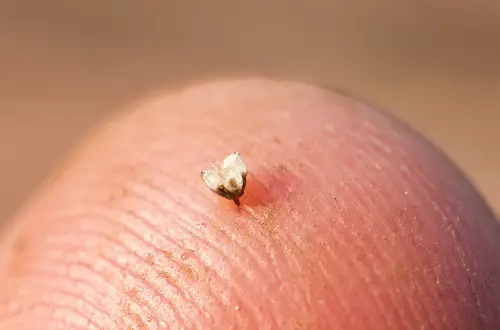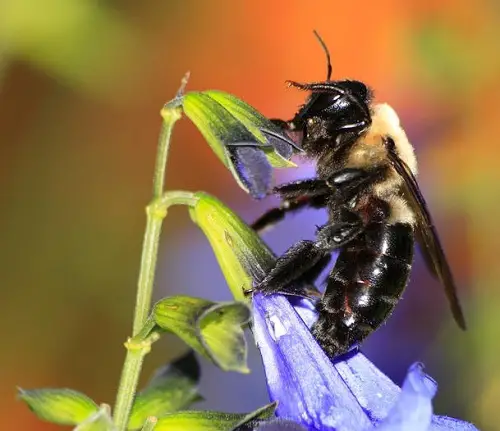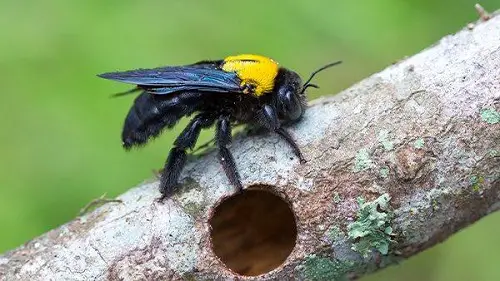Do Carpenter Bees Sting? Is it Painful? Are there any ways to prevent it? Read on to know all the details and more!
Carpenter bees are large, solitary bees that are often found in wood structures such as decks, porches, and eaves. While they can be beneficial pollinators, many people are wary of them because of their size and their tendency to bore holes in wood. So, Do Carpenter Bees Sting? Let’s find out!
Do Carpenter Bees Sting?
Yes, Carpenter bees can sting. However, they are not aggressive and don’t attack unless they feel threatened or provoked. Male carpenter bees are more likely to be aggressive than females, but they do not have stingers.
Female carpenter bees have stingers, but they are not usually aggressive and will only sting if they feel threatened or if they are handled roughly.
Carpenter bee stings are not usually dangerous, but they can be painful. The sting can cause swelling, redness, and itching, and some people may experience an allergic reaction. If you are stung by a carpenter bee and experience symptoms such as difficulty breathing, dizziness, or swelling of the face or throat, seek medical attention immediately.
Can Carpenter Bees Sting You Repeatedly?
Unlike honeybees, carpenter bees can sting repeatedly without losing their stinger. However, carpenter bees are not typically aggressive and will only sting if they feel threatened or provoked. In most cases, carpenter bees will simply fly away if they feel that their nest or territory is being threatened.
In general, carpenter bee stings are not as common as other types of bee attacks, such as honeybee or wasp. However, they can still be painful and cause a reaction in some people. If you are allergic to bee stings, it’s important to carry an epinephrine auto-injector with you at all times in case of an emergency.
Are Carpenter Bees Dangerous?
 Carpenter bees are generally not considered dangerous to humans, but they can be a nuisance and cause damage to wooden structures. Females can bore holes in wood to create nests for their eggs, which can weaken the structural integrity of the wood.
Carpenter bees are generally not considered dangerous to humans, but they can be a nuisance and cause damage to wooden structures. Females can bore holes in wood to create nests for their eggs, which can weaken the structural integrity of the wood.
While these bees are not typically aggressive and will only attack when they feel threatened or provoked, their stings can still be painful and cause a reaction in some people. In rare cases, people may experience an allergic reaction to carpenter bee stings, which can be life-threatening if left untreated.
However, it’s important to note that carpenter bees are an important part of the ecosystem and play a role in pollination. In addition, they are often preyed upon by birds and other animals.
How to Prevent Carpenter Bee Sting?
If you want to prevent carpenter bee stings, there are a few steps you can take:
- Wear Protective Clothing: When working outside, wear long sleeves, pants, and gloves. If you work near an area where carpenter bees are active, consider wearing a beekeeping suit for added protection.
- Avoid Provoking: Carpenter bees are unlikely to attack unless they feel threatened or provoked. Avoid swatting at them or making sudden movements near their nests.
- Keep Your Distance: If you see them near their nests, it’s best to keep your distance. Avoid standing or walking near the nests, and try to stay calm and quiet.
- Seal Entry Points: To prevent carpenter bees from entering your home or other structures, seal any entry points with caulk or another sealant. They are attracted to untreated wood, so consider painting or staining any exposed wood to make it less attractive to them.
- Use Traps: These traps use pheromones to attract the bees, and once they enter the trap, they are unable to escape.
Check out some amazing bee garden ideas
Symptoms of Carpenter Bee Sting
Carpenter bee stings can cause pain, swelling, and redness. In some cases, people may experience an allergic reaction, which can cause symptoms such as hives, difficulty breathing, dizziness, and swelling of the face or throat.
If you experience any of these symptoms after being stung by a carpenter bee, seek medical attention immediately.
Treatment for Carpenter Bee Stings
- Clean the Area: Use soap and water to clean the area around the sting. This will help prevent infection and reduce the risk of further irritation.
- Apply Ice: Applying an ice pack or a cold compress can help reduce pain and swelling. Wrap the ice pack or compress it in a towel before applying it to your skin to prevent frostbite.
- Take Pain Medication: Over-the-counter pain medication such as ibuprofen or acetaminophen can help reduce pain and swelling.
- Use Topical Creams: There are several over-the-counter creams and ointments available that can help reduce pain and itching. Look for products that contain ingredients such as lidocaine, hydrocortisone, or benzocaine.
- Apply Toothpaste: Apply a thin layer of toothpaste to the affected area. It will help to numb the pain and will provide a cooling sensation.
When to Seek Medical Attention?

Most carpenter bee stings can be treated at home with over-the-counter medications and home remedies. However, if you experience symptoms such as difficulty breathing, dizziness, or swelling of the face or throat, seek medical attention immediately.
These symptoms could indicate an allergic reaction, which can be life-threatening if left untreated.
Preventing Carpenter Bee Stings
The best way to prevent the attack is to avoid disturbing their nests. If you have an infestation on your property, consider calling a professional pest control company to remove the bees safely.
Wear protective clothing and take precautions to avoid provoking the bees.
How to Get Rid of Carpenter Bees?
- Carpenter bees like to nest in wood that is soft and unpainted, so it is important to remove any potential nesting sites. Replace any damaged wood and fill any holes and cracks. Paint any exposed wood and keep up with regular painting and staining.
- Place traps around the areas where you have seen carpenter bee activity. Make sure you place the traps in areas where the bees will be able to find them easily.
- If the carpenter’s bee activity is severe, you may need to spray an insecticide to get rid of them. Make sure you follow all directions when using insecticides.
- Call a professional. If the infestation is particularly severe, you may want to call a professional pest control company for help. They can help get rid of the carpenter bees and provide advice on how to prevent them from coming back.
Carpenter Bee vs Bumble Bee
The biggest difference between a carpenter bee and a bumble bee is its size. Carpenter bees are much larger than bumble bees, reaching up to two inches in length. These bees also have a black abdomen and yellow or white markings on their thorax, while bumble bees have a fuzzy yellow and black abdomen.
Bumble bees are social insects and live in colonies, while carpenter bees are solitary and nest in wood.







